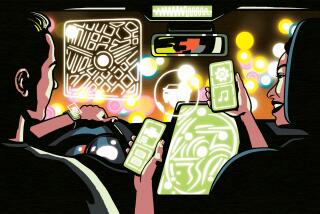Ford to offer hands-free mobility
- Share via
Digital music, Bluetooth-enabled cellphone, text messages you can hear -- all in one integrated package.
The latest pricey gadget from Apple?
Nope, it’s the latest car from Ford Motor Co.
The automaker, in partnership with Microsoft Corp., is rolling out what it hopes will be a game changer in the world of mobile connectivity.
It’s called Sync -- a hands-free calling, voice-activated music-selection and voice-text-messaging system powered by software that can be upgraded to mesh with new generations of cellphones, digital music players and other devices.
Priced right now as a $395 option and available initially in a dozen Ford, Lincoln and Mercury models, the system is designed to appeal to the iPod generation of 18-to-35-year-old motorists who don’t necessarily associate the Blue Oval with cutting-edge cool.
“It’s not by chance that the first car we’re offering this in is the Focus, our most inexpensive car,” said Ford spokesman Mark Schirmer. “This can’t be some $2,000 option that only rich people are going to put in their cars.”
Sync won’t be in showrooms until later this month, but Ford has been showing off demo versions around the country for several months. Response from critics has been generally upbeat -- with Popular Mechanics, for instance, praising it for being “as flexible as a Romanian gymnast.”
“I haven’t seen anybody demonstrate a more holistic infotainment system for the car,” said Danielle Levitas, a senior analyst at market research firm IDC.
Reviewers have been particularly impressed by Sync’s voice recognition capability.
Many automakers now offer connections for digital music players such as the iPod or the Microsoft Zune. Sync goes a step further by allowing the driver to select songs without taking his eyes off the road to hunt through a playlist.
Say “play artist Elvis Presley,” for example, and Sync will search the files of the connected music player and cue up whatever songs it finds by the King. Say “play track ‘Blue Suede Shoes’ ” and it’ll play that song (providing it’s on the device’s playlist, of course.)
Sync can also be told to play music by genre (jazz, hip-hop, etc.) or to search for songs based on beats per minute or other factors.
The system also can receive text messages and read them aloud, interpreting a hundred or so shorthand messages such as LOL for “laughing out loud.” (And yes, Sync will read swear words; it won’t, however, decipher obscene acronyms.) Ford engineers, by the way, named Sync’s digitized female voice “Samantha.”
Text messages can’t be returned orally. In cars equipped with easy-to-read touch screens, such as those used in on-board navigation systems, the driver can reply by selecting one of a dozen or so short replies from the display.
Sync’s Windows-based operating system can be updated to work with new personal electronic devices, which consumers tend to swap out more frequently than their vehicles.
“I’ve bought six cellphones and five iPods since I bought my last car,” said wireless analyst Julie Ask of Jupiter Research.
Sync is part of the movement toward marrying the car with its owner’s personal infotainment devices -- personal computer, cellphone or digital music player.
Building on the demand for in-car technology fueled by satellite radio, GPS navigation and monitoring services such as General Motors Corp.’s OnStar, automakers have been racing to make their vehicles compatible with the ever-changing array of personal technology devices carried by their customers.
Hands-free calling, in particular, has become a common feature in recent years as states pass laws against using hand-held cellphones while driving (California’s takes effect next July). But portable music players like the iPod have become key drivers of the movement as well.
GM, for instance, offers an audio system in the Cadillac CTS that includes a 40-gigabyte hard drive for storing files uploaded from digital music players. Chrysler offers the MyGig system, which includes audio, video, navigation and hands-free phoning.
And even more advanced systems are arriving or are just around the corner.
Mercedes-Benz, for instance, has teamed with Yahoo Inc. and Google Inc. on a new service that allows motorists to e-mail driving directions from their computers to their cars, giving them more control over selecting their routes.
GM’s OnStar offers a similar service through MapQuest.
Next up: synchronizing onboard navigation systems with real-time traffic reports.
And in the (perhaps) distant future? Ford researchers reportedly are working on a navigation system that uses a technology known as “path prediction” to anticipate a vehicle’s likely route and prepare it for known hazards.
It remains unclear how much of this motorists are willing to pay for. A recent survey by Jupiter found that navigation systems and safety features such as remote door unlocking and stolen vehicle tracking are attractive to a third or more of car owners. Features such as car-based e-mail systems ranked much lower.
And safety questions continue to dog the carmakers, even in the realm of hands-free devices. Safety experts in the insurance industry have complained that hands-free devices still can divert a driver’s attention from the road.
Ford says it’s just trying to provide services that drivers want in their cars.
“Customers are coming into dealerships and asking, ‘I use my phone when I drive, I play my music player in the car. Is there an easier way to do that?’ ” said Ford’s Schirmer. “Our job is to find a more convenient way to do that.”
--
--
On latimes.com
See how the Sync functions with text messages and music devices at latimes.com/thegarage.






